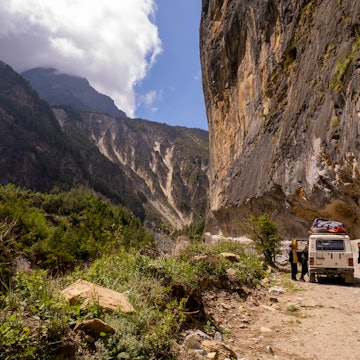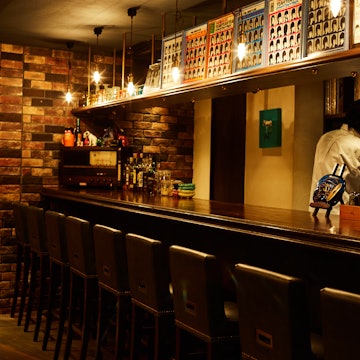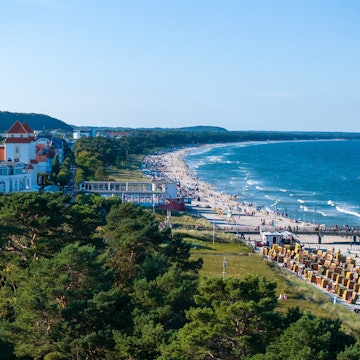
How the Guggenheim Museum remains a haven of artistic wonder in the crowded NYC landscape
Sep 14, 2021 • 4 min read

The Solomon R. Guggenheim Museum is one of New York City's most iconic buildings © James Leynse / Getty Images
With the launch of Lonely Planet's Ultimate United States Travel List, we wanted to explore some of our favorite American destinations and zoom in a little closer.
Each piece begins with a bird's-eye view of a uniquely American site's history and impact and then zooms in to reveal the lived experience on the ground.
In this article, New York City native Denise Vasquez explores the historical and architectural importance of the Solomon R. Guggenheim Museum.

Breathe in the aroma of sautéed onions, sauerkraut and hot dogs flowing through the air. Whirl through the hustle and bustle of people racing along Fifth Avenue to 88th Street. Upon arrival, behold the architectural monument shining bright from the outside in: the Solomon R. Guggenheim Museum. The historic landmark emerges from other tall buildings standing around it, like a superstar of abstract art.
35,000 feet: The foundation of a "temple of spirit"
The vision of bringing the museum to life began in 1943. Hilla Rebay, art advisor to Solomon Guggenheim and director of the Museum of Non-Objective Painting, commissioned Frank Lloyd Wright to design a one-of-a-kind “temple of spirit” to hold Guggenheim’s art collection. After 700 sketches, six working drafts, and years of hard work, the building opened on October 21, 1959.
Nature was Wright’s influence, experience his teacher and interconnection his guide. Composing the unity between the art, the building and its environment was his symphony, and the Guggenheim was arguably his greatest masterpiece.

But his genius was not obvious to everyone. Wright’s vision was greeted with mixed reviews. Prominent artists signed a petition against the building. Critics called it names like “giant toilet bowl,” while others praised the monument for its beauty.
To get a true sense of it all, take a seat outside on the concrete ledge that surrounds the building. Let your imagination run wild while admiring the design. Maybe you see the museum as a spaceship, a sea shell or a child’s spinning top toy frozen in time, as the circular stack spirals upward growing wider and wider. Interpretation is yours to play with.
Unwind, have a snack, and find solace in the trees all around you. Leave behind the city noise, and embark on an adventure that will move you in every way. A journey of the body, mind and spirit awaits.

5000 feet: Exhibits
The Guggenheim attracts visitors from all over the world. It’s a cultural center filled with exhibits that take you for a ride in a time machine. Past exhibits have included “Picasso and the War Years 1935-1945” and “Ellsworth Kelly: A Retrospective,” which included five decades of his photography, paintings and sculptures.
Look to the future at “A Year With Children,” an annual exhibit that features students participating in the Learning Through Art artist-in-residence program.
The Guggenheim’s curators, scholars, conservators and artists work as a team to find the best methods for long-term maintenance of its permanent collection. To prevent deterioration, researchers study the materials and techniques that artists used.
On the ground: The Guggenheim Museum today
Enter the building for an introduction to another world within a world. The fountain splashes and voices echo around the circular space, carrying you through the plaza like a surfer riding a wave.
Look up at the skylight, or oculus, 96ft above and on a particularly sunny day, bathe in the light that peeks through. The iconic rotunda is sure to grab your attention next.
The quarter-mile-long spiral ramp, which increases at a gentle incline, means the museum can be enjoyed by just about everyone.
Run your fingertips along the freshly painted parapet and feel the layers of days gone by in every bump.

Visitors with limited mobility can go to the security guard at the entrance and borrow a manual wheelchair for the day free of charge. Wheelchair users roam freely around the building with access to every level, except at the top of the first ramp.
Two stairs stand at the entrance of the High Gallery, but take the elevator to Rotunda level 1 or 2 to view inside. There are restrooms on levels 1 and 7 that are compliant with the Americans with Disabilities Act (ADA).
Visitors who are blind or have low vision may sign up for Mind’s Eye program, which has been presenting a view of the art and world through oral descriptions for over a decade.
People who are deaf or hard of hearing can request American Sign Language (ASL) interpretation for tours, programs and workshops. Make your reservations one to two weeks before the event dates and bring your service animal.
Venture to the museum Thursday through Monday from 11am to 6pm. Become a member and enjoy some benefits like free entry and exclusive hours on certain Mondays from 6 to 8 pm. Take advantage of the pay-what-you-wish admission on certain Saturdays from 4 to 6 pm. Discounted admission is available to visitors with disabilities and caregivers get in free of charge.
You might also like:
Best things to do on Roosevelt Island in New York City
The 14 most popular beaches in New York City
The ultimate ‘Friends’ guide to NYC















